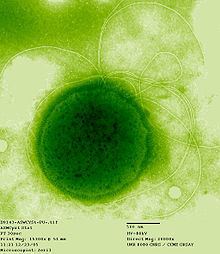Higher classification Thermococcus | Rank Species | |
 | ||
Scientific name Thermococcus gammatolerans Similar Thermococcus, Archaeans, Thermococcales, Thermococcus barophilus, Thermococcus kodakarensis | ||
Thermococcus gammatolerans is an archaea extremophile and the most radiation-resistant organism known to exist.
Contents
Discovered in 2003 in a submarine hydrothermal vent in the Guaymas Basin about 2,000 meters deep off the coast of California, Thermococcus gammatolerans thrives in temperatures between 55–95 °C with an optimum development at approximately 88 °C. The optimal growth pH is 6, favoring the presence of sulfur (S), which is reduced to hydrogen sulfide (H
2S). It is the organism with the strongest known resistance to radiation, supporting a radiation of gamma rays from 30,000 gray (Gy).
Along with the genera Palaeococcus and Pyrococcus, Thermococcus belongs to the Thermococcaceae family, sole family of the Thermococci (called "Protoarchaea" by Cavalier-Smith), a class in the phylum Euryarchaeota of Archaea. Thermococcus species live in extremely hot environments such as hydrothermal vents with a growth optimum temperature above 80 °C. Thermococcus and Pyrococcus (literally "ball of fire") are both chemoorganotrophic anaerobic required. Thermococcus spp. prefer 70–95 °C, whereas Pyrococcus prefer 70–100 °C.
The resistance to ionizing radiation of T. gammatolerans is enormous. While a dose of 5 Gy is sufficient to kill a human, and a dose of 60 Gy is able to kill all cells in a colony of E. coli, Thermococcus gammatolerans can withstand doses of up to 30,000 Gy, and an instantaneous dose of up to 5,000 Gy with no loss of viability.
History
Thermococcus gammatolerans was discovered in 2003 in samples collected from a hydrothermal chimney at the Guaymas Basin about 2,000 meters deep off the coast of California, (27° 1' N, 111° 24' W).
Mechanisms of resistance to radiation
Unlike other organisms, cell survival in Thermococcus gammatolerans is not altered by changing conditions in its growth phase, but the lack of ideal conditions and nutrients decreases its radioresistance. The system of chromosomal DNA repair shows that cells in stationary phase of growth reconstitute DNA more rapidly than cells in exponential growth phase. T. gammatolerans can slowly or quickly rebuild damaged chromosomes without loss of viability.
Applications
There has been study of its application to the development of new enzymatic markers that are resistant to high temperatures and their application in the study of carcinogenesis and the study of the development of mitochondrial diseases. It has been speculated that DNA repair mechanisms of T. gammatolerans could be incorporated into the genome of higher species in order to improve DNA repair and reduce cellular aging.
Etymology
Thermococcus: Greek feminine noun thermê (θέρμη), heat; Neolatin masculine noun coccus (from Greek masculine noun kokkos (κόκκος), berry), coccus; Neolatin masculine noun Thermococcus, coccus existing in hot environment. gammatolerans: Gr. gamma (γάμμα), referring to gamma rays; Latin participle adjective tolerans, tolerating; Neolatin participle adjective gammatolerans, referring to its ability to tolerate high levels of γ-rays.
